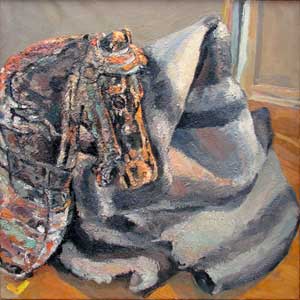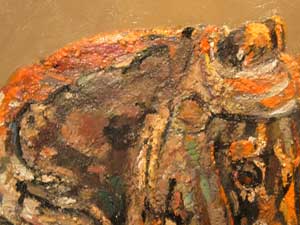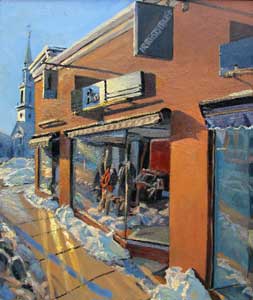
George Nick Trojan Horse 2008 oil on linen 30 x 30 inches
Interview with George Nick Part Six, On the Trojan Horse and thoughts on Teaching
Larry Groff:
In your last show at the Gallery Naga, I heard you say that the still life of the painted horse in drapery, as being the strongest painting in the show. “It is a wonderful, intense and mysterious painting to me, but I’m not sure I understand it.” You titled it, The Trojan Horse, and I wonder if the title has some significance.
There was a couple of other still lives that seem related, with the exquisite color, and amazing paint surface, almost sculpted. I was hoping you could say more about this painting.
George Nick:
There was a goal in that painting. The goal in that painting — I felt that the realization that we talk of earlier — I never felt that anything I had ever done was pushed through to the final degree, both emotionally and intellectually. I was satisfied with the drawing of it, the shape of it, the tone of it, how it fit in with the rest of the painting — all that kind of stuff — intellectually, and that I really liked it emotionally.
No painting I’ve ever done was completely done that way. As a matter of fact, this one was not done that way. I only got the horse, I didn’t get the background, I couldn’t carry it out, all the way, but I worked on that painting every day for three months, and my wife felt that I was never going to do another painting the rest of my life, and she worried about me.
But the thing is that I did get resolutions that I never got before, and I felt, that’s why I keep pushing the paint these days, is that I find as I keep going, the painting doesn’t go downhill, it’s going up, it’s getting better.
I want it better, and it’s feeding me, so I keep doing this process. That was part of that very complicated process, and I couldn’t keep doing that, because I’d scream. I was screaming while I was doing it, but I wanted to do it. Somehow I set these goals at different times, and I succeed at what I’m aiming for, at the time. A simple goal like climbing a mountain.
I’m not sure why I can’t come up with one process to paint everything, but I have never ever — I keep on switching and jumping around. I think I’m doing the same thing, but I fit things closer to one side of my character, or the other side, and it sort of rounds itself out, I think
I titled it The Trojan Horse because there’s something romantic and mysterious about the title. I had this wooden horse, ever since I knew Dickinson, and I’ve been looking all this time, painted many times, and that’s all the paintings I did that I succeeded. I’m not sure I’ll paint it again. I certainly won’t paint it that way. But I knew the horse very well, and I think I achieved what I wanted, after looking at it all these years. I didn’t plan it that way, it’s just that it seems to have come out that way.
The title — there’s something strange about it, and there is something worrisome about
The Trojan Horse, and it has something that’s vaguely philosophic to do with life, I think. I like romantic titles like that.

George Nick Detail from the Trojan Horse
LG:
What about the drapery in the painting?
George Nick:
Oh, the drapery. Well, that was a rug. That’s a rug that we had gotten from Bulgaria that’s made out of goats hair. It’s not sewn, it’s pressed together, and we’ve had it for like thirty-five years. My wife doesn’t like it to be out, very much, because it sheds incessantly. [Laughing]
George Nick:
But I liked it, and it was sort of a compliment, in some sort of lyrical way, but a simplified lyrical way with the horse, and I liked them together, that’s all. I thought I worked out that very well. I think it’s a background with the stretchers, and so forth, that were done in about four minutes; but I left it at that. That’s all.

George Nick The Coded Process 15 Feb 2009 2009 oil on linen 30 x 20 inches
LG:
Last question. You’ve spent much of your career teaching, and have received widespread recognition for being a great educator. You have taught hundreds of students over the years to become better painters.
Today many schools seem to place more emphasis on conceptual matters, such as social or psychological messages in art, and much less emphasis on teaching traditional skills, of painting from observation.
With this in mind, what advice would you give today’s students, who are looking for the best possible education that prepares them for being a realist painter? Or can you give advice?
George Nick:
I’m from the Mediterranean, with a lot of history and heritage, and I’ve have a lot of false theatre and bravado, so I would attempt anything. And I would attempt to give advice, too.
The first thing — it’s more like thousands than hundreds of students, okay?
LG:
Okay.
George Nick:
Because I was figuring it out a few years ago, and I figured out I’d had about six to eight thousand students. I don’t know if I counted everybody. You see, the bravado comes out quickly.
LG:
Hey, you need the credit where it’s due.
George Nick:
Well, you’re not supposed to give it to yourself.
LG:
[Laughing] Well, you know I thought of doing that. I said, “Gee, I don’t know — hundreds, thousands,” but okay.
George Nick:
Well, school is a part of the world and the environment. If you look at the art magazines and businesses called galleries, and the promotions, and so forth, that go on, and you find that it has a flavor, and the flavor is what the schools imitate. So, I think they belong to the world probably more than I do. But I don’t criticize. I don’t feel one way or another about it. I think that anybody wants to, with the best possible education, prepare one for a real education.
There’s a couple of things. First, you find a teacher like Edward Dickinson, and secondly, you go to the museums and see who has done it — other people have done it — even who are both living today. I think by example, you learn a lot.
I think once Dickinson told me — I told him that, “I’m so glad that I’m studying with you, that I’m learning this stuff.”
He said, “Oh, well, you would figure it out yourself, but I probably save you five years,” he said, very casually.

George Nick Tribute to John Updike 26 Jan 2009 2009 oil on linen 38 x 32 inches
In retrospect, I think, more or less, it’s true. People figure out a lot by themselves. We get a few hints here and there, but it fits in with your genes and your desires and your needs, and so, you would work it out, one way or another. I don’t think we’re so separate or so unique. I think the talents are unique, but I think the mind and man, himself, is seeking the general things that are possible.
The impossible feat of making a three-dimensional image out of [a] two-dimensional surface is part in your genes, I think. I think there are enough people around still wanting to do that, that do it, and make art out of it, so it’s like people who make rugs. I think it’s in their genes. They have some talent that’s available, and they develop the skills because it’s of interest to them, and they see they can make something that pleases them, if they work at it.
[podcast]http://gnick_interview.s3.amazonaws.com/georgeNickintervAll.mp3[/podcast]To Interview with George Nick, Part One, On Edwin Dickinson
To Interview with George Nick, Part Two, On Fairfield Porter
To Interview with George Nick Part Three, On George Bellows
To Interview with George Nick Part Four, On Cezanne and color
To Interview with George Nick Part Five, On Drawing





Larry, thanks so much for posting this wonderful interview with George Nick, as well as all of the work you put into this blog. I find that I check it as much as my own email. There is always something waiting to grab my attention and make me think about the act of painting as well as the differing philosophies regarding painterly realism in general. I have you to thank for introducing me to George Nick’s work and have been eagerly awaiting this posting since you spoke about it last week. He is a true master of this craft, and is a constant inspiration to me and my work.
thanks Jimmy, great to read your comment. I hope to continue making this place the kind of blog I’d want to keep coming back to. I peeked at your website – some wonderful painting there. Hope to hear and see more from you.
Wonderful interview, Larry. Thank you.
Thanks Hunter! It was a pleasure to work on.
Wow, what a treat. Fantastic interview Larry. Thank you as always for your hard work.
Can’t wait for the Eric Aho interview… I have been looking at his work for a while now and been anxious to learn more about him.
Thanks Erik! Eric’s interview should be up by Monday. We are doing some final tweaking.
Awesome Larry! Cant wait for the next one!
Larry,
For quite some time I have been following your blog as you know, and I have come to perceive a couple of things. One, that many artists may be coming to it as a form of “home” in their solitary and noble search to try to be good painters. It’s a good thing to not feel like you are completely alone, though most of the time we are. I think we painters probably worry often if we are trying hard enough.
The comments through the blog and not just in this interview often turn towards incredible teachers of the recent past, and I wonder if this is because many people feel like they “missed the boat” in some way. I sometimes worry about people who sincerely want to learn, and cannot find the right place. What do other people think about the current system of art education? Where are the good places to go today? I often have people asking me, but I don’t have a clue where to send them.
The great thing is that you have just given the most priceless gift. In these five interviews which you can read over and over again, it is like finding a Real Art Lesson, one which many may not have had. It does not surprise me in the least that these painters got together and talked technique or modern art. Put two painters together and they probably start talking about pizza.
I especially liked Nick’s concluding comment about Dickinson telling him he would have figured this all out for himself in time. I think that is so right- all teaching can do is speed up the process a little.
Larry,
I am so pleased to have found your website. George Nick is my friend and will always be my mentor. He has always been an inspiration since I studied with him in the 70’s. When the going gets tough I always think of George, working it out, making it work.
George is a strong and forceful personality, and this shapes his teaching too. His early history with Dickinson was pivital in his own work and subsequently his own teaching. The fact that he did not try to teach ART but the fundamentals that IF one had them one could search for their way of painting was his gift. I was lucky to have had George at Hollins University for a semester as outr Atist in Residence and he was great as a colleague and teacher. His high expectation of himself seemed to be in the air, and others would feel it too and try to be their best. Those who had good teachers like George are fortunate as we have a foundation that is there for us no matter in which way we choose to go with our own work. The statement made by E.D. to George that “there is room for everyone” was true then and now. George would say it often when a painter would be claiming to be “neglected” by the art world and critics and I think it could have been his way of saying too – be yourself and do the best you can, and let the chips fall where they may. George’s work keeps getting better with age, and his energy seems endless as he paints. I hope it lasts forever.
Wonderful, thanks. I too studied with E.Dickinson at The A.S.L. in 1957,8,9, & helped in his studio. Moving from here to there , & painted his last N.Y.C. studio “Manet Grey” ( to avoid reflected light). I was interviewed with Lennart Anderson in 1980 but the recorder was not working, so I made a video on E.D.”s teaching methods. It is on my web-site http://www.johnleavey.com (upper left) for anyone to see. There is also a demonstration of 20 minutes on You Tube that I don’t know how to find but it is there. Good luck we all need it. John Leavey